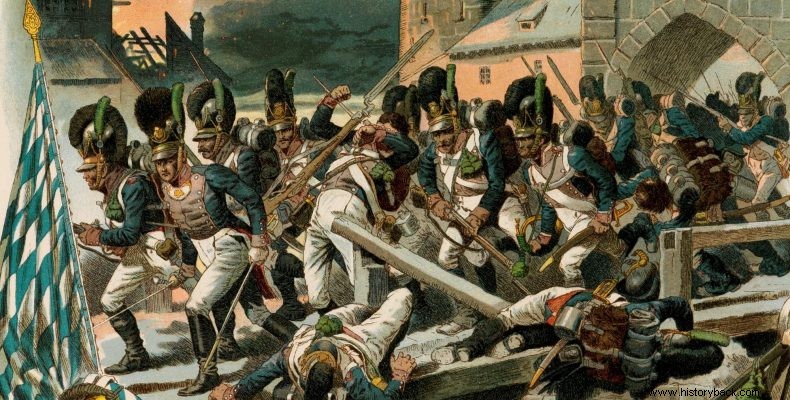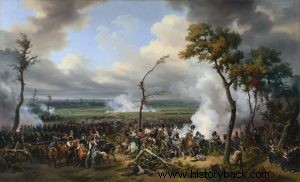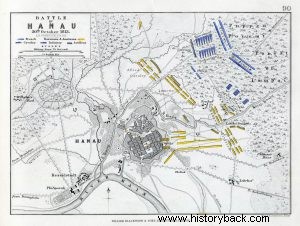
The battle of Leipzig proved to be the most disastrous for the French arms of the Napoleonic Wars. The combined forces of the Allied Prussians, Russians, Austrians and some Germans overwhelmed the French forces under Napoleon himself. After the defeat, Bonaparte with the remnants of his forces moved towards France in order to reorganize and supplement them for the continuation of the war.
The defeat at Leipzig resulted in Napoleon losing control of Germany for good. And those German allies or by force "allies" who were left sided with the Allies. A country that had been a loyal ally of France until then was Bavaria. But now he had no choice but to change sides and save himself from the wrath of the Allies. The battle at Hanau served precisely this purpose... It was a political battle from which Bavaria would emerge victorious whether it won or lost...
Taking advantage of Bavaria's accession to the 6th Anti-French Coalition, the Allies conceived the plan to cut off Napoleon's route of retreat. A mixed force was thus formed consisting of an Austrian and a Bavarian Army Corps (SS) under the Bavarian general Karl von Wrede. Wrede's force numbered 24,000 Austrian and 18,000 Bavarian soldiers (33,000 infantry, 9,000 cavalry and 94 guns). Brede believed that the French remnants were not worth fighting and that he would not face more than 20,000 demoralized soldiers. He fell out in both of his calculations.
Although indeed in Leipzig it was disbanded, under Napoleon's "magical" hand the French army had begun to regroup while retreating. In Hanau, Napoleon had about 30,000 men at his disposal. On October 29, 1813, Brende arrived in the Hanau region with the intention of holding the road to Frankfurt on the Main River and Mainz. The Bavarian general ordered his forces – two Austrian and two Bavarian Infantry Divisions (MP), an Austrian Cavalry Division (MI) and a Bavarian Cavalry Brigade (TI) in great depth on a relatively small front in front of the Kinchig River, a tributary of Maine. He sent light divisions of his infantry into the forest of Lamboi, in front of the main line of battle.
The cavalry was placed in the second line, while the artillery was deployed in front of the infantry. The Bavarian general supported his right flank on the city of Hanau and his left on the marshy ground there. Wrede's mistake was that he ordered his forces with the river at his back. Thus, in the event of a need to retreat or reinforce the forces of his front line, there would inevitably be a serious problem. In the meantime, Napoleon had been informed, by his agents, of the movements of his opponents and acted accordingly.
After sending his transports by another route, along with 1/3 of his forces, he prepared for battle, deploying Marshal Victor's II SS (a single MP) on his left flank. In the center were Macdonald's XI SS (a single MP), the infantry of the Imperial Guard, under Drouot (2 MP ~ 6,000 men), and the SI of the Guard (4 MI, 4,000 men). On his right, in the second line, he commanded General Sebastiani's II Cavalry Corps (Sip. – 3,000 men). Napoleon commissioned Macdonald and the Guard to clear the forest of Lampoy. He would then throw the bulk of his forces against the allied left and center.
The battle began on October 30 and from the beginning developed favorably for Napoleon. By noon the Guard had cleared the forest, and the French force was deployed on the plan of its grand chief. The French fired 50 guns at the Allied center and managed to silence the 28 Allied forces there. Then the French stormed out. The allied line did not hold. And Brende's attempt to reinforce the forces of his first line did not succeed as they tried to cross the Kinchig River by the only bridge that existed at the site and fatal confusion was created.
Despite this fact, however, Brede managed, with his personal intervention, to regroup the sections of his front line and form a new battle line, stopping the French. However, when night fell he retreated leaving the critical path to salvation open for Napoleon. The battle was over. The defeated allies suffered 9,000 casualties (dead, wounded, captured). Corresponding, direct, French losses were also heavy, amounting to 6,000 men.
Unfortunately for Napoleon, his retreating army, despite his – Pyrrhic – victory was further disorganized and 10,000 more French soldiers were captured in the following days. Thus Napoleon's tactical success turned into a strategic defeat, although he escaped the trap. Five days later the Allies were in Frankfurt. Napoleon held out for a few more months, fighting inside French territory, now, until defeated and forced to capitulate and surrender.

Phase of the Battle of Hanau. Bavarian dragoons can be seen charging at French forces.

